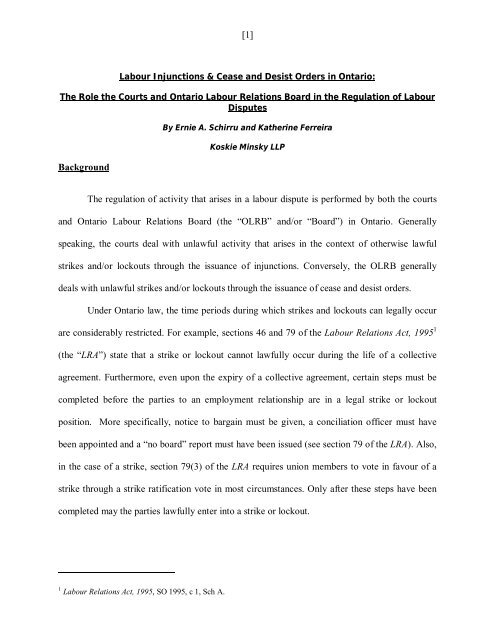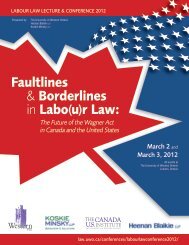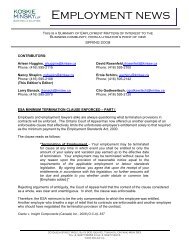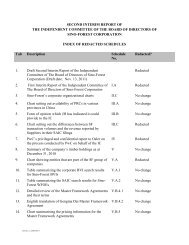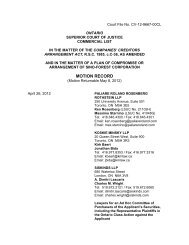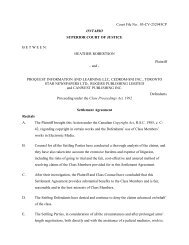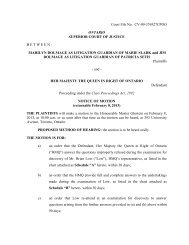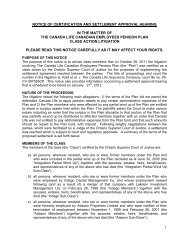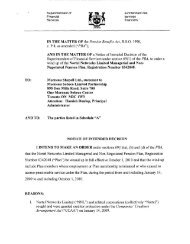Labour Injunctions & Cease and Desist Orders in Ontario
Labour Injunctions & Cease and Desist Orders in Ontario
Labour Injunctions & Cease and Desist Orders in Ontario
You also want an ePaper? Increase the reach of your titles
YUMPU automatically turns print PDFs into web optimized ePapers that Google loves.
[1]<br />
<strong>Labour</strong> <strong>Injunctions</strong> & <strong>Cease</strong> <strong>and</strong> <strong>Desist</strong> <strong>Orders</strong> <strong>in</strong> <strong>Ontario</strong>:<br />
The Role the Courts <strong>and</strong> <strong>Ontario</strong> <strong>Labour</strong> Relations Board <strong>in</strong> the Regulation of <strong>Labour</strong><br />
Disputes<br />
Background<br />
By Ernie A. Schirru <strong>and</strong> Kather<strong>in</strong>e Ferreira<br />
Koskie M<strong>in</strong>sky LLP<br />
The regulation of activity that arises <strong>in</strong> a labour dispute is performed by both the courts<br />
<strong>and</strong> <strong>Ontario</strong> <strong>Labour</strong> Relations Board (the “OLRB” <strong>and</strong>/or “Board”) <strong>in</strong> <strong>Ontario</strong>. Generally<br />
speak<strong>in</strong>g, the courts deal with unlawful activity that arises <strong>in</strong> the context of otherwise lawful<br />
strikes <strong>and</strong>/or lockouts through the issuance of <strong>in</strong>junctions. Conversely, the OLRB generally<br />
deals with unlawful strikes <strong>and</strong>/or lockouts through the issuance of cease <strong>and</strong> desist orders.<br />
Under <strong>Ontario</strong> law, the time periods dur<strong>in</strong>g which strikes <strong>and</strong> lockouts can legally occur<br />
are considerably restricted. For example, sections 46 <strong>and</strong> 79 of the <strong>Labour</strong> Relations Act, 1995 1<br />
(the “LRA”) state that a strike or lockout cannot lawfully occur dur<strong>in</strong>g the life of a collective<br />
agreement. Furthermore, even upon the expiry of a collective agreement, certa<strong>in</strong> steps must be<br />
completed before the parties to an employment relationship are <strong>in</strong> a legal strike or lockout<br />
position. More specifically, notice to barga<strong>in</strong> must be given, a conciliation officer must have<br />
been appo<strong>in</strong>ted <strong>and</strong> a “no board”report must have been issued (see section 79 of the LRA). Also,<br />
<strong>in</strong> the case of a strike, section 79(3) of the LRA requires union members to vote <strong>in</strong> favour of a<br />
strike through a strike ratification vote <strong>in</strong> most circumstances. Only after these steps have been<br />
completed may the parties lawfully enter <strong>in</strong>to a strike or lockout.<br />
1 <strong>Labour</strong> Relations Act, 1995, SO 1995, c 1, Sch A.
[2]<br />
A<br />
<strong>Injunctions</strong>: Lawful Strikes/Lockouts & Unlawful Activity<br />
Where a lawful strike or lockout occurs, any alleged unlawful activity usually arises <strong>in</strong><br />
the context of picket<strong>in</strong>g. To date, the sem<strong>in</strong>al case on picket<strong>in</strong>g rema<strong>in</strong>s the 2002 decision of the<br />
Supreme Court of Canada (the “SCC”) <strong>in</strong> R.W.D.S.U., Local 558 v. Pepsi-Cola Canada<br />
Beverages (West) Ltd. 2<br />
(“Pepsi-Cola”). In Pepsi-Cola, the SCC outl<strong>in</strong>ed what constitutes<br />
picket<strong>in</strong>g, how picket<strong>in</strong>g relates to the freedom of expression set out <strong>in</strong> section 2(b) of the<br />
Canadian Charter of Rights <strong>and</strong> Freedoms 3 (the “Charter”) <strong>and</strong> the conditions under which<br />
picket<strong>in</strong>g is considered an illegal activity.<br />
The SCC did not provide an exhaustive def<strong>in</strong>ition of picket<strong>in</strong>g <strong>in</strong> Pepsi-Cola. However,<br />
the SCC did expla<strong>in</strong> its underst<strong>and</strong><strong>in</strong>g of what constitutes picket<strong>in</strong>g as follows:<br />
In labour law, picket<strong>in</strong>g is commonly understood as an organized<br />
effort of people carry<strong>in</strong>g placards <strong>in</strong> a public place at or near<br />
bus<strong>in</strong>ess premises. The act of picket<strong>in</strong>g <strong>in</strong>volves an element of<br />
physical presence, which <strong>in</strong> turn <strong>in</strong>corporates an expressive<br />
component. Its purposes are usually twofold: first, to convey<br />
<strong>in</strong>formation about a labour dispute <strong>in</strong> order to ga<strong>in</strong> support for its<br />
cause from other workers, clients of the struck employer, or the<br />
general public, <strong>and</strong> second, to put social <strong>and</strong> economic pressure on<br />
the employer <strong>and</strong>, often by extension, on its suppliers <strong>and</strong> clients. 4<br />
The SCC also clarified that picket<strong>in</strong>g always <strong>in</strong>volves expressive action which engages the<br />
freedom of expression set out <strong>in</strong> section 2(b) of the Charter. Accord<strong>in</strong>g to the SCC <strong>in</strong> Pepsi-<br />
Cola, freedom of expression is “particularly critical” <strong>in</strong> a labour relations context for the<br />
follow<strong>in</strong>g reasons:<br />
2 R.W.D.S.U., Local 558 v Pepsi-Cola Canada Beverages (West) Ltd., [2002] 1 SCR 156 [Pepsi-Cola].<br />
3 Canadian Charter of Rights <strong>and</strong> Freedoms, Part I of the Constitution Act, 1982, be<strong>in</strong>g Schedule B to the Canada<br />
Act 1982 (UK), 1982, c 11.<br />
4 Pepsi-Cola, supra note 1 at para 27.
[3]<br />
It is through free expression that employees are able to def<strong>in</strong>e <strong>and</strong><br />
articulate their common <strong>in</strong>terests <strong>and</strong>, <strong>in</strong> the event of a labour<br />
dispute, elicit the support of the general public <strong>in</strong> the furtherance of<br />
their cause. 5<br />
The SCC’s decision <strong>in</strong> Pepsi-Cola is also significant because the court outl<strong>in</strong>es <strong>and</strong><br />
applies the “wrongful action”model <strong>in</strong> its assessment of the lawfulness of the picket<strong>in</strong>g activity<br />
at issue <strong>in</strong> that case. Consistent with the values underly<strong>in</strong>g the Charter, <strong>and</strong> <strong>in</strong> particular the<br />
freedom of expression, the SCC’s application of the wrongful action model <strong>in</strong> Pepsi-Coal treats<br />
picket<strong>in</strong>g as a lawful form of expressive activity that should only be restra<strong>in</strong>ed <strong>in</strong> limited<br />
circumstances, like when it results to tortious or crim<strong>in</strong>al conduct. In approach<strong>in</strong>g picket<strong>in</strong>g <strong>in</strong><br />
this way, the SCC stated that the <strong>in</strong>fliction of some economic harm as a result of picket<strong>in</strong>g is<br />
expected <strong>and</strong> acceptable:<br />
… with<strong>in</strong> limits, unions <strong>and</strong> employers may legitimately exert<br />
economic pressure on each other to the end of resolv<strong>in</strong>g their<br />
dispute. Thus, employees are entitled to withdraw their services,<br />
<strong>in</strong>flict<strong>in</strong>g economic harm directly on their employer <strong>and</strong> <strong>in</strong>directly<br />
on third parties which do bus<strong>in</strong>ess with their employer. Employers<br />
are similarly entitled to exert economic pressure on their<br />
employees through the use of lockouts <strong>and</strong>, <strong>in</strong> most jurisdictions <strong>in</strong><br />
Canada, through the hir<strong>in</strong>g of replacement workers. 6<br />
The SCC also held that the <strong>in</strong>fliction of some economic harm on third parties is acceptable “as a<br />
necessary cost of resolv<strong>in</strong>g <strong>in</strong>dustrial conflict.” 7<br />
The Crim<strong>in</strong>al Code 8 offences that are most likely to arise <strong>in</strong> the context of picket<strong>in</strong>g are<br />
mischief, common nuisance <strong>and</strong> threats of violence. These offences are listed <strong>in</strong> sections 430(1),<br />
180 <strong>and</strong> 423(1) of the Crim<strong>in</strong>al Code respectively.<br />
5 Ibid. at para 34.<br />
6 Pepsi-Cola, supra note 1 at para 24.<br />
7 Ibid. at para 45.
[4]<br />
In Pepsi-Cola, the SCC enunciated a number of nom<strong>in</strong>ate torts that are most likely to<br />
arise <strong>in</strong> the course of picket<strong>in</strong>g which may justify court <strong>in</strong>tervention:<br />
Picket<strong>in</strong>g which breaches… one of the specific torts like trespass,<br />
nuisance, <strong>in</strong>timidation, defamation or misrepresentation will be<br />
impermissible, regardless of where it occurs.” 9<br />
In addition, the SCC held that the commission of an economic tort is sufficient to render<br />
picket<strong>in</strong>g unlawful. The SCC specifically referred to three such economic torts that may be<br />
wrongful for the purposes of picket<strong>in</strong>g: (1) <strong>in</strong>duc<strong>in</strong>g breach of contract, (2) conspiracy to <strong>in</strong>jure<br />
<strong>and</strong> (3) <strong>in</strong>terference with contractual relations. To date, few <strong>Ontario</strong> cases have considered<br />
whether a union committed an economic tort <strong>in</strong> the context of picket<strong>in</strong>g. However, where there is<br />
evidence that elements of one or more economic tort is likely to be established at a hear<strong>in</strong>g on<br />
the merits, the court will issue an <strong>in</strong>junction. 10<br />
(i)<br />
The Courts of Justice Act<br />
In <strong>Ontario</strong>, challenges to the lawfulness of picket<strong>in</strong>g generally arise <strong>in</strong> the context of<br />
<strong>in</strong>junction applications. Section 102 of the Courts of Justice Act 11 provides that the court may<br />
grant an <strong>in</strong>junction to restra<strong>in</strong> a person from an act <strong>in</strong> connection with a labour dispute. Section<br />
102(1) def<strong>in</strong>es a labour dispute as follows:<br />
a dispute or difference concern<strong>in</strong>g terms, tenure or conditions of<br />
employment or concern<strong>in</strong>g the association or representation of<br />
persons <strong>in</strong> negotiat<strong>in</strong>g, fix<strong>in</strong>g, ma<strong>in</strong>ta<strong>in</strong><strong>in</strong>g, chang<strong>in</strong>g or seek<strong>in</strong>g to<br />
arrange terms or conditions of employment, regardless of whether<br />
the disputants st<strong>and</strong> <strong>in</strong> the proximate relation of employer <strong>and</strong><br />
employee<br />
8 Crim<strong>in</strong>al Code, RSC 1985, c C-46.<br />
9 Pepsi-Cola, supra note 1 at para 103.<br />
10 Vale Inco Ltd. United Steel, Paper <strong>and</strong> Forestry, Rubber, Manufactur<strong>in</strong>g, Energy, Allied Industrial <strong>and</strong> Service<br />
Workers, Local 6500, [2010] OJ No 1169 (Ont Sup Ct).<br />
11 Courts of Justice Act, RSO 1990, c C 43.
[5]<br />
Section 102(3) then provides that <strong>in</strong> order for an <strong>in</strong>junction to be issued an employer must satisfy<br />
the court that:<br />
reasonable efforts to obta<strong>in</strong> police assistance, protection <strong>and</strong> action<br />
to prevent or remove any alleged danger of damage to property,<br />
<strong>in</strong>jury to persons, obstruction of or <strong>in</strong>terference with lawful entry<br />
or exit from the premises <strong>in</strong> question or breach of the peace have<br />
been unsuccessful.<br />
The court has considered the circumstances under which it will f<strong>in</strong>d that reasonable efforts to<br />
obta<strong>in</strong> police assistance have been unsuccessful with<strong>in</strong> the mean<strong>in</strong>g of section 102(3).<br />
Specifically, the courts considered the issue <strong>in</strong> Industrial Hardwood Products (1996) Ltd. v.<br />
International Wood & Allied Workers of Canada, Local 2693 12 (“Industrial Hardwood”) <strong>and</strong><br />
Cancoil Thermal Corp. v. Abbott 13 (“Cancoil”).<br />
Industrial Hardwood <strong>in</strong>volved an <strong>in</strong>junction issued under section 102(3) of the Courts of<br />
Justice Act <strong>in</strong> relation to a legal strike. Dur<strong>in</strong>g the course of the strike, the employer had hired<br />
replacement workers <strong>and</strong> used vans to transport them <strong>in</strong>to <strong>and</strong> out of the company premises. For<br />
approximately three months, picket<strong>in</strong>g employees obstructed the vans. However, the picketers<br />
would obey police orders <strong>and</strong> move when <strong>in</strong>structed to do so by the police. The employer<br />
obta<strong>in</strong>ed an <strong>in</strong>junction under section 102(3) that prohibited picketers from prevent<strong>in</strong>g or<br />
attempt<strong>in</strong>g to prevent vehicular access to the company’s premises. The <strong>in</strong>junction also prohibited<br />
all picket<strong>in</strong>g at the plant except picket<strong>in</strong>g for the purpose of communicat<strong>in</strong>g <strong>in</strong>formation to those<br />
wish<strong>in</strong>g to receive it. Such communications were limited to five m<strong>in</strong>utes <strong>in</strong> length under the<br />
terms of the <strong>in</strong>junction. F<strong>in</strong>ally, the <strong>in</strong>junction limited the number of picketers to four at each<br />
plant entrance. The union appealed the <strong>in</strong>junction order, argu<strong>in</strong>g that because the picketers<br />
12 Industrial Hardwood Products (1996) Ltd. v International Wood & Allied Workers of Canada, Local 2693 (2001),<br />
196 DLR (4th) 320, 52 OR (3d) 694 (Ont CA) [Industrial Hardwood].<br />
13 Cancoil Thermal Corp. v Abbott, [2004] OJ No 3016 (Ont Sup Ct) [Cancoil].
[6]<br />
obeyed police orders to allow vehicles to enter the company’s premises when the police were<br />
called the requirement under section 102(3) that efforts to obta<strong>in</strong> police assistance be<br />
unsuccessful had not been satisfied.<br />
The <strong>Ontario</strong> Court of Appeal did not accept the union’s argument <strong>and</strong> dismissed the<br />
appeal. In dismiss<strong>in</strong>g the appeal, the Court of Appeal clarified the purpose of section 102(3). It<br />
stated: “The question posed by s. 102(3) is whether <strong>in</strong> all the circumstances reasonable efforts to<br />
obta<strong>in</strong> police assistance have failed to result <strong>in</strong> an acceptable degree of control of the situation.” 14<br />
The Court of Appeal also outl<strong>in</strong>ed what an applicant must prove under section 102(3) as follows:<br />
the section places an onus on the applicant to satisfy the court that<br />
the applicant has made reasonable efforts to obta<strong>in</strong> police<br />
assistance <strong>and</strong> that those efforts have not resulted <strong>in</strong> an acceptable<br />
degree of control <strong>in</strong> light of the factors set out <strong>in</strong> the section: the<br />
risks of property damage, personal <strong>in</strong>jury or obstruction of lawful<br />
access to the premises. 15<br />
With respect to the established pattern of picket<strong>in</strong>g whereby picketers blocked vehicles from<br />
enter<strong>in</strong>g <strong>and</strong> exit<strong>in</strong>g the premises, the Court of Appeal found that the employer had established<br />
that reasonable efforts to obta<strong>in</strong> police assistance had failed to result <strong>in</strong> an acceptable degree of<br />
control as required under section 102(3). Section 102(3) does not contemplate that an employer<br />
should have access to its premises blocked every day until the police arrive nor does it purport to<br />
assess the success of police assistance <strong>in</strong> prevent<strong>in</strong>g obstruction only after the police have arrived<br />
at the premises <strong>in</strong> question.<br />
However, it should be noted that even though the Court of Appeal upheld the <strong>in</strong>junction,<br />
<strong>in</strong> do<strong>in</strong>g so, it commented that <strong>in</strong>junctions should be used spar<strong>in</strong>gly <strong>in</strong> a labour relations context.<br />
14 Industrial Hardwood, supra note 12 at para 23.<br />
15 Ibid. at para 22.
[7]<br />
The Court of Appeal specifically noted that the regulation of picket<strong>in</strong>g dur<strong>in</strong>g a labour dispute<br />
must be done with care, balance <strong>and</strong> sophistication. To this end, the Court of Appeal went on to<br />
say:<br />
Strikes <strong>and</strong> the picket l<strong>in</strong>es that go with them are evolv<strong>in</strong>g human<br />
dramas where risks of property damage, personal <strong>in</strong>jury or<br />
obstruction of lawful entry are best controlled by flexible <strong>and</strong><br />
even-h<strong>and</strong>ed polic<strong>in</strong>g. Only where this fails should the court, with<br />
its blunt <strong>in</strong>strument of the <strong>in</strong>junction, be resorted to. 16<br />
It is worthy of not<strong>in</strong>g that although the Court of Appeal <strong>in</strong> Industrial Hardwood upheld the<br />
<strong>in</strong>junction issued by the lower court, the Court of Appeal did modify one aspect of the <strong>in</strong>junction<br />
- the restriction on the number of picketers was removed. The Court of Appeal removed the<br />
restriction because it found that the number of picketers is an expression of solidarity <strong>and</strong><br />
consequently, an important component of the expressive aspect of picket<strong>in</strong>g. Remov<strong>in</strong>g the<br />
limitation on the number of picketers reflected the court’s view that where <strong>in</strong>junctions are issued<br />
“they ought generally to go no further than necessary to prevent a recurrence of the demonstrated<br />
harm.” 17 Similarly, Cancoil <strong>in</strong>volved a lawful strike <strong>in</strong> which employees picketed the entrance to<br />
the company’s premises. The picketers deta<strong>in</strong>ed each person who attempted to cross the picket<br />
l<strong>in</strong>e for at least fifteen m<strong>in</strong>utes <strong>and</strong> if a vehicle had several occupants the fifteen m<strong>in</strong>ute delay<br />
was multiplied by the number of occupants. The employer responded by impos<strong>in</strong>g a staggered<br />
entry schedule but this caused significant <strong>in</strong>convenience to some of its employees. The employer<br />
also contacted the police but was <strong>in</strong>formed that the police would not <strong>in</strong>tervene <strong>in</strong> a labour dispute<br />
unless there was a risk to public safety or the commission of a crim<strong>in</strong>al offence. The employer<br />
16 Industrial Hardwood, supra note 12 at para 16.<br />
17 Ibid. at para 38.
[8]<br />
sought an <strong>in</strong>junction to restra<strong>in</strong> the picket<strong>in</strong>g. At issue was whether the police’s refusal to<br />
<strong>in</strong>tervene <strong>in</strong> a labour dispute satisfied the requirement under section 102(3) that reasonable<br />
efforts to obta<strong>in</strong> police assistance to prevent the obstruction of or <strong>in</strong>terference with the lawful<br />
entry <strong>and</strong> exit from premises have been unsuccessful.<br />
The <strong>Ontario</strong> Superior Court of Justice found that the police’s refusal to <strong>in</strong>tervene could<br />
satisfy the requirement under section 102(3). The court held:<br />
The unwill<strong>in</strong>gness of the police to become <strong>in</strong>volved must not be<br />
allowed to preclude the Courts <strong>in</strong>tervention <strong>in</strong> appropriate cases<br />
where, <strong>in</strong> the Court’s view, tortious or crim<strong>in</strong>al activity is<br />
occurr<strong>in</strong>g. As Justice Goudge noted <strong>in</strong> Industrial Hardwood<br />
Product (1996) Ltd., supra, that <strong>in</strong> cases <strong>in</strong>volv<strong>in</strong>g obstruction of<br />
lawful entry or exit (not property damage or personal <strong>in</strong>jury) the<br />
relevant considerations <strong>in</strong>clude the degree of obstruction, its<br />
duration on each occasion <strong>and</strong> how many days it has gone on… In<br />
my view, the test <strong>in</strong> section 102 would be met hav<strong>in</strong>g regard to the<br />
non<strong>in</strong>tervention policy of the K<strong>in</strong>gston police, but only if the<br />
employer can succeed <strong>in</strong> establish<strong>in</strong>g a sufficiently serious ongo<strong>in</strong>g<br />
obstruction <strong>in</strong> the manner contemplated by the Court of Appeal. 18<br />
Thus, the court found that the police’s refusal to <strong>in</strong>tervene <strong>in</strong> a labour dispute was sufficient to<br />
satisfy the requirement provided under section 102(3). However, despite this f<strong>in</strong>d<strong>in</strong>g the court<br />
ultimately refused to grant the <strong>in</strong>junction. In refus<strong>in</strong>g to grant the <strong>in</strong>junction, the court<br />
emphasized the fact that the employer had decl<strong>in</strong>ed to negotiate a picket l<strong>in</strong>e protocol with the<br />
union despite the union’s ongo<strong>in</strong>g <strong>and</strong> good faith <strong>in</strong>vitation to do so. The court felt that to grant<br />
an <strong>in</strong>junction under such circumstances would be <strong>in</strong>consistent with the restra<strong>in</strong>t that courts<br />
should exercise when <strong>in</strong>terven<strong>in</strong>g with labour disputes.<br />
18 Cancoil, supra note 13 at paras 17-18.
[9]<br />
Therefore, while section 102(3) of the Courts of Justice Act provides that the courts may<br />
issue <strong>in</strong>junctions <strong>in</strong> relation to labour disputes, the judicial reason<strong>in</strong>g <strong>in</strong> Industrial Hardwood <strong>and</strong><br />
Cancoil <strong>in</strong>dicates that the courts will likely exercise restra<strong>in</strong>t <strong>in</strong> order<strong>in</strong>g <strong>in</strong>junctions.<br />
Furthermore, as <strong>in</strong>dicated <strong>in</strong> Industrial Hardwood, where <strong>in</strong>junctions are ordered, they will likely<br />
not go farther than is necessary to address the harm at issue.<br />
(ii)<br />
The RJR-MacDonald Test<br />
In addition to the criteria provided for <strong>in</strong> section 102(3) of the Courts of Justice Act, the<br />
test from RJR-MacDonald Inc. v. Canada (Attorney General) 19 (“RJR-MacDonald”) must be<br />
satisfied <strong>in</strong> order for an <strong>in</strong>junction to be issued <strong>in</strong> a labour dispute. RJR-MacDonald requires that<br />
the party seek<strong>in</strong>g an <strong>in</strong>junction establish the follow<strong>in</strong>g:<br />
(1) there is a serious question to be tried,<br />
(2) the pla<strong>in</strong>tiff will suffer irreparable harm which cannot be adequately compensated<br />
by damages, <strong>and</strong><br />
(3) that the balance of convenience favours grant<strong>in</strong>g the <strong>in</strong>junction.<br />
S<strong>in</strong>ce the Pepsi-Cola decision, <strong>Ontario</strong> courts have generally found that the three<br />
elements of the RJR MacDonald test are satisfied <strong>in</strong> a dispute relat<strong>in</strong>g to picket<strong>in</strong>g activity when<br />
it appears that there is sufficient evidence upon which tortious or crim<strong>in</strong>al liability may be found.<br />
For this reason, there is often little dispute over whether the picket<strong>in</strong>g activities be<strong>in</strong>g<br />
compla<strong>in</strong>ed of raise a serious question to be tried under the first branch of the RJR-MacDonald<br />
test. With respect to the second branch of the test, courts have consistently found that irreparable<br />
19 RJR-MacDonald Inc. v Canada (Attorney General), [1994] 1 SCR 311.
[10]<br />
harm will readily be established when the evidence demonstrates that picketers are likely<br />
engag<strong>in</strong>g <strong>in</strong> deliberate tortious or crim<strong>in</strong>al actions for which damages are an <strong>in</strong>adequate remedy.<br />
F<strong>in</strong>ally, with respect to the third branch, courts have consistently found that the balance of<br />
convenience favours the grant<strong>in</strong>g of an <strong>in</strong>junction when the picket<strong>in</strong>g at issue goes beyond the<br />
communication of views. Southern Sanitation Inc. (c.o.b. Wasteco) v. Fiore 20<br />
(“Southern<br />
Sanitation”) <strong>and</strong> Aramark Canada Ltd. v. Keat<strong>in</strong>g 21 are two such <strong>Ontario</strong> Superior Court cases<br />
that reflect the courts’approach to <strong>and</strong> application of the RJR-MacDonald test <strong>in</strong> the context of a<br />
labour dispute. These cases reflect the fact that the issuance of an <strong>in</strong>junction will turn on whether<br />
the employer has established the existence of sufficient evidence that would support a f<strong>in</strong>d<strong>in</strong>g<br />
that the union has engaged <strong>in</strong> tortious or crim<strong>in</strong>al conduct <strong>in</strong> the course of picket<strong>in</strong>g if the matter<br />
were to proceed to trial.<br />
A review of <strong>Ontario</strong> jurisprudence follow<strong>in</strong>g the Pepsi-Cola decision <strong>in</strong>dicates that<br />
employers most commonly seek an <strong>in</strong>junction to prohibit picket<strong>in</strong>g activity where it has impeded<br />
the ability of workers, customers, suppliers <strong>and</strong> the public to enter or exit an employer’s<br />
premises. Consistent with the Pepsi-Cola decision, courts have generally found that a union’s<br />
picket<strong>in</strong>g activities are lawful provided that their primary purpose is to communicate <strong>in</strong>formation<br />
to the public. Courts have also emphasized that any delays to <strong>in</strong>dividuals enter<strong>in</strong>g or exit<strong>in</strong>g the<br />
employer’s premises as a result of picket<strong>in</strong>g related communications should be brief <strong>and</strong> not<br />
exceed the amount of time reasonably necessary for the picketers to convey their message. This<br />
20 Southern Sanitation Inc. (c.o.b. Wasteco) v Fiore, [2009] OJ No 2936 (Ont Sup Ct) [Southern Sanitation].<br />
21 Aramark Canada Ltd. v Keat<strong>in</strong>g, [2002] OJ No 3505 (Ont Sup Ct).
[11]<br />
approach is evident <strong>in</strong> the courts’reason<strong>in</strong>g <strong>in</strong> Southern Sanitation <strong>and</strong> Brookfield Properties<br />
Ltd. v Hoath 22 (“Brookfield Properties Ltd.”).<br />
Southern Sanitation <strong>in</strong>volved a lawful strike by CUPE Local 416 aga<strong>in</strong>st the City of<br />
Toronto. As a result of the strike, a third party company called Wasteco was provid<strong>in</strong>g garbage<br />
collection services that otherwise would have been h<strong>and</strong>led by the union. Given its <strong>in</strong>volvement,<br />
Wasteco collection sites were picketed by CUPE Local 416 members. The picket<strong>in</strong>g <strong>in</strong>volved<br />
blockades <strong>and</strong> threats. The City of Toronto obta<strong>in</strong>ed an <strong>in</strong>junction that allowed union members<br />
to picket but limited any delays result<strong>in</strong>g from picket<strong>in</strong>g to five m<strong>in</strong>utes. The <strong>in</strong>junction also<br />
specified that picket<strong>in</strong>g was to be conducted for “<strong>in</strong>formational purposes only.” 23<br />
In Brookfield Properties Ltd., the union was picket<strong>in</strong>g a large office complex <strong>in</strong><br />
downtown Toronto owned by the employer, Brookfield. The picket<strong>in</strong>g was largely centered on<br />
the entrances <strong>and</strong> exits to the office complex’s park<strong>in</strong>g garage as well as its receiv<strong>in</strong>g dock. At<br />
the outset of the strike the union <strong>and</strong> employer had agreed upon a picket<strong>in</strong>g protocol. However,<br />
as the dispute progressed the union began to depart from the protocol. The employer successfully<br />
obta<strong>in</strong>ed an <strong>in</strong>junction that limited the picketers’ability to delay entrance to <strong>and</strong> exit from the<br />
park<strong>in</strong>g garage except <strong>in</strong> accordance with the previously agreed upon picket<strong>in</strong>g protocol. The<br />
<strong>in</strong>junction also conta<strong>in</strong>ed a prohibition aga<strong>in</strong>st “<strong>in</strong>terfer<strong>in</strong>g with, block<strong>in</strong>g, obstruct<strong>in</strong>g or<br />
delay<strong>in</strong>g, <strong>in</strong> any way whatsoever”the entry of vehicles <strong>in</strong>to the park<strong>in</strong>g garage between 6:30<br />
a.m. <strong>and</strong> 9 a.m. any day of the week <strong>and</strong> exit from the receiv<strong>in</strong>g dock at any time. 24 In grant<strong>in</strong>g<br />
the <strong>in</strong>junction, the court commented on the fact that delays associated with picket<strong>in</strong>g should be<br />
for <strong>in</strong>formational purposes. It stated:<br />
22 Brookfield Properties Ltd. v Hoath, [2010] OJ No 4822 (Ont Sup Ct) [Brookfield Properties Ltd.].<br />
23 Southern Sanitation, supra note 20 at para 68.<br />
24 Brookfield Properties Ltd., supra note 22 at para 64.
[12]<br />
the case law dist<strong>in</strong>guishes two very different situations. Picket<strong>in</strong>g<br />
which constitutes obstruction of the lawful entry to <strong>and</strong> exit from<br />
premises is unlawful, constitut<strong>in</strong>g a nuisance. That the blockad<strong>in</strong>g<br />
or obstruction occurs dur<strong>in</strong>g a labour dispute does not transform an<br />
unlawful nuisance <strong>in</strong>to a lawful expression of a message. However,<br />
picket<strong>in</strong>g which attempts to communicate <strong>in</strong>formation to those<br />
attempt<strong>in</strong>g to enter <strong>in</strong>to or leave premises may result <strong>in</strong> temporary<br />
delays where the targets of the communicated message stop <strong>and</strong><br />
engage the picketers <strong>in</strong> discussion. Delays <strong>in</strong>cidental to such<br />
communication which last only for the amount of time reasonably<br />
required to convey the message may fall <strong>in</strong>to the categories of<br />
permissible impedance, rather than unlawful obstruction or<br />
blockage. 25<br />
This comment <strong>in</strong>dicates the importance that the courts place on the fact that the predom<strong>in</strong>ant<br />
purpose of any delays associated with picket<strong>in</strong>g should be the communication of <strong>in</strong>formation <strong>and</strong><br />
not to exert economic pressure. As a result of this emphasis, the courts are likely to f<strong>in</strong>d that<br />
picketers who primarily attempt to block entry to an employer’s property <strong>and</strong> place secondary<br />
focus on communicat<strong>in</strong>g <strong>in</strong>formation are act<strong>in</strong>g unlawfully. For <strong>in</strong>stance, <strong>in</strong> a recent <strong>Ontario</strong><br />
Superior Court decision, Alumicor Ltd. v. U.S.W. 26 , the court granted an <strong>in</strong>junction which<br />
prohibited the picket<strong>in</strong>g union from delay<strong>in</strong>g access to or egress from the employer’s premises as<br />
a result of picket<strong>in</strong>g. The court prohibited any delays because it found that the picketers were<br />
merely try<strong>in</strong>g to blockade the employer’s premises as opposed to engag<strong>in</strong>g <strong>in</strong> communication<br />
with those try<strong>in</strong>g to exit <strong>and</strong> enter the premises. The court made this f<strong>in</strong>d<strong>in</strong>g even though the<br />
picketers wore placards <strong>and</strong> had posted <strong>in</strong>formation signs <strong>in</strong> the picket<strong>in</strong>g area. Accord<strong>in</strong>g to the<br />
court, these placards <strong>and</strong> signs were <strong>in</strong>sufficient to support a f<strong>in</strong>d<strong>in</strong>g that the picket<strong>in</strong>g was for<br />
<strong>in</strong>formational purposes. The court emphasized the fact that the picketers who impeded access to<br />
the employer’s property did not verbally communicate any views <strong>in</strong> relation to the union’s<br />
<strong>in</strong>terests <strong>in</strong> the labour dispute. Rather, the communications to <strong>in</strong>dividuals or drivers enter<strong>in</strong>g or<br />
25 Brookfield Properties Ltd., supra note 22 at para 36.<br />
26 Alumicor Ltd. v U.S.W., [2011] OJ No 1433 (Ont Sup Ct).
[13]<br />
leav<strong>in</strong>g the employer’s facility were limited to statements to the effect that “absolutely noth<strong>in</strong>g is<br />
go<strong>in</strong>g to get <strong>in</strong> or out of this place.”<br />
B<br />
<strong>Cease</strong> <strong>and</strong> <strong>Desist</strong> <strong>Orders</strong>: Unlawful Strikes/Lockouts<br />
Unlike the courts, the OLRB does not have a general jurisdiction over lawful strikes<br />
<strong>and</strong>/or lockouts <strong>and</strong> therefore does not generally address the restrictions (if any) that may be<br />
placed on picket l<strong>in</strong>e activity <strong>in</strong> the event of a lawful strike. The OLRB does not issue<br />
<strong>in</strong>junctions. Rather, as outl<strong>in</strong>ed by the OLRB <strong>in</strong> Toronto Transit Commission, 27<br />
the Board<br />
addresses “questions of unlawful strikes or unlawful picket<strong>in</strong>g, where the <strong>in</strong>dividuals on strike or<br />
who are likely to strike are not legally entitled to do so.” 28<br />
Section 1(1) of the LRA def<strong>in</strong>es a strike as follows:<br />
‘strike’<strong>in</strong>cludes a cessation of work, a refusal to work or to<br />
cont<strong>in</strong>ue to work by employees <strong>in</strong> comb<strong>in</strong>ation or <strong>in</strong> concert or <strong>in</strong><br />
accordance with a common underst<strong>and</strong><strong>in</strong>g, or a slow-down or other<br />
concerted activity on the part of employees designed to restrict or<br />
limit output<br />
In addition, the Board recently outl<strong>in</strong>ed its underst<strong>and</strong><strong>in</strong>g of strikes <strong>in</strong> Benteler Automotive<br />
Canada Corporation. 29 The Board described strikes as follows:<br />
Strikes are permitted only where there is no collective agreement<br />
<strong>in</strong> force, <strong>and</strong> the barga<strong>in</strong><strong>in</strong>g parties have completed the compulsory<br />
conciliation process contemplated by the statute. ‘Strikes’at any<br />
other time are unlawful; moreover, the def<strong>in</strong>ition of ‘strike’is quite<br />
elastic, <strong>and</strong> encompasses any work refusal by a group of<br />
27 Toronto Transit Commission, [1996] OLRB Rep September/October 889.<br />
28 Ibid. at para 14.<br />
29 Benteler Automotive Canada Corporation, [2011] CanLII 17940 (ON LRB).
[14]<br />
employees ‘<strong>in</strong> concert, <strong>in</strong> comb<strong>in</strong>ation, or <strong>in</strong> accordance with a<br />
common underst<strong>and</strong><strong>in</strong>g’. Those words have been held to<br />
encompass a broad range of collective activity <strong>in</strong>clud<strong>in</strong>g:<br />
slowdowns, ‘hot cargo arrangements’, ‘sympathy strikes’<strong>and</strong> a<br />
concerted refusal to cross picket l<strong>in</strong>es as an expression of solidarity<br />
with the actions of another trade union. The def<strong>in</strong>ition is<br />
<strong>in</strong>tentionally cast <strong>in</strong> very broad terms, <strong>and</strong> has been so construed<br />
by both the Boards <strong>and</strong> the Courts. 30<br />
Thus, a strike is a work refusal by a group of employees act<strong>in</strong>g <strong>in</strong> concert, <strong>in</strong> comb<strong>in</strong>ation or <strong>in</strong><br />
accordance with a common underst<strong>and</strong><strong>in</strong>g. This def<strong>in</strong>ition has been <strong>in</strong>terpreted broadly <strong>and</strong>,<br />
consequently, may be applicable <strong>in</strong> a wide variety of circumstances. As already discussed,<br />
generally speak<strong>in</strong>g, strikes are unlawful unless the applicable collective agreement is no longer<br />
<strong>in</strong> force <strong>and</strong> the parties to the employment relationship have completed the conciliation process<br />
m<strong>and</strong>ated by section 79 of the LRA.<br />
Where unlawful strike activity is occurr<strong>in</strong>g, the OLRB has the jurisdiction to exercise its<br />
discretion to issue declarations, directions <strong>and</strong> orders under sections 100 <strong>and</strong> 101 of the LRA.<br />
The remedy commonly sought from the Board <strong>in</strong> section 100 <strong>and</strong>/or 101 cases is the issuance of<br />
a cease <strong>and</strong> desist order. The Board <strong>in</strong> Monarch F<strong>in</strong>e Foods Company Limited 31 affirmed that<br />
employers could seek a cease <strong>and</strong> desist order <strong>in</strong> the event of an unlawful strike. <strong>Cease</strong> <strong>and</strong> desist<br />
orders prohibit a person or persons from cont<strong>in</strong>u<strong>in</strong>g a particular course of conduct – like an<br />
unlawful strike. Any cease <strong>and</strong> desist order issued by the Board may be filed <strong>in</strong> the Superior<br />
Court of Justice. Upon do<strong>in</strong>g so, the order becomes enforceable as an order of that court pursuant<br />
to section 102 of the LRA.<br />
30 Benteler Automotive Canada Corporation, supra note 29 at para 5.<br />
31 Monarch F<strong>in</strong>e Foods Company Limited, [1986] OLRB Rep May 661.
[15]<br />
The declarations, directions <strong>and</strong> orders available under sections 100 <strong>and</strong> 101 of the LRA<br />
are discretionary <strong>in</strong> nature. In Bechtel Canada Ltd. 32 the OLRB stated that any declarations,<br />
directions <strong>and</strong>/or orders made under sections 100 or 101 of the LRA are not available as of right<br />
<strong>and</strong> will usually not be issued <strong>in</strong> circumstances where the work stoppage at issue ends before the<br />
Board hear<strong>in</strong>g. The OLRB <strong>in</strong> Bechtel Canada Ltd. did, however, outl<strong>in</strong>e three exceptions to this<br />
general approach, as follows:<br />
The Board has consistently stated, however, that it will depart from<br />
this general practice of refus<strong>in</strong>g to grant either a declaration or a<br />
direction <strong>in</strong> the face of the existence of any one or more of the<br />
follow<strong>in</strong>g three circumstances: firstly, where the evidence<br />
establishes a past practice of unlawful strike activity, secondly,<br />
where the evidence <strong>in</strong>dicates that the unlawful activity is likely to<br />
recur or thirdly, where the unlawful strike upon which the<br />
application is based has implications which extend beyond the<br />
immediate parties. 33<br />
While Bechtel Canada Ltd. is an older decision, the approach set out <strong>in</strong> that decision was<br />
affirmed by the OLRB relatively recently <strong>in</strong> the Board’s 2008 decision <strong>in</strong> Enw<strong>in</strong> Utilities Ltd. 34<br />
Similar to the courts’approach <strong>in</strong> issu<strong>in</strong>g <strong>in</strong>junctions, the OLRB jurisprudence shows<br />
that the Board attempts to exercise its discretion <strong>in</strong> section 100 or 101 cases <strong>in</strong> such a way so as<br />
to ensure any declarations, directions <strong>and</strong>/or orders are construed as narrowly as possible s<strong>in</strong>ce<br />
the matters at issue typically engage the Charter right of freedom of expression <strong>and</strong> possibly<br />
freedom of association as well. This po<strong>in</strong>t was emphasized by the OLRB <strong>in</strong> Toronto Transit<br />
Commission, when the Board stated:<br />
… significant Charter Rights are at issue <strong>in</strong> the circumstances.<br />
Even though the Board is satisfied that there must be some limits<br />
32 Bechtel Canada Ltd., [1977] OLRB Rep May 269.<br />
33 Bechtel Canada Ltd., supra note 32 at para 20.<br />
34 Enw<strong>in</strong> Utilities Ltd., [2008] CanLII 20885 (ON LRB).
[16]<br />
placed upon the rights of people to express themselves <strong>and</strong> to<br />
assemble, <strong>in</strong> order to ensure that no unlawful strike occurs, any<br />
limitation should be as narrow as possible, reflect<strong>in</strong>g the<br />
significant <strong>and</strong> critical rights at issue. 35<br />
Consequently, the Board <strong>in</strong> Toronto Transit Commission issued a cease <strong>and</strong> desist order that only<br />
prohibited the picket<strong>in</strong>g of TTC sites prior to 6:30 a.m dur<strong>in</strong>g the 1996 “Days of Protest.”There<br />
were no restrictions on picket<strong>in</strong>g after 6:30 a.m. as the Board reasoned that TTC collectors<br />
would have been able to enter the subway stations by that time. The OLRB held that a<br />
prohibition on picket<strong>in</strong>g prior to 6:30 a.m. was sufficient to ensure that TTC collectors were not<br />
<strong>in</strong> a position whereby they would have to cross a picket l<strong>in</strong>e <strong>in</strong> order to report to work, possibly<br />
lead<strong>in</strong>g to an unlawful strike if they refused to cross.<br />
The Board’s prohibition on picket<strong>in</strong>g <strong>in</strong> order to prevent TTC collectors from hav<strong>in</strong>g to<br />
cross a picket l<strong>in</strong>e <strong>in</strong> order to report to work reflects the situation at issue <strong>in</strong> most of the Board’s<br />
decisions relat<strong>in</strong>g to requests for cease <strong>and</strong> desist orders. <strong>Cease</strong> <strong>and</strong> desist orders are often<br />
requested <strong>in</strong> circumstances where a union that is legally on strike engages <strong>in</strong> secondary picket<strong>in</strong>g<br />
at third party sites where other unionized workers are employed. Such picket<strong>in</strong>g often results <strong>in</strong><br />
the unionized employees refus<strong>in</strong>g to cross the picket l<strong>in</strong>e, thereby lead<strong>in</strong>g to an unlawful strike.<br />
This type of activity is often said to engage section 83(1) of the LRA, which provides:<br />
No person shall do any act if the person knows or ought to know<br />
that, as a probable <strong>and</strong> reasonable consequence of the act, another<br />
person or persons will engage <strong>in</strong> an unlawful strike or an unlawful<br />
lock-out.<br />
Unionized employees have been found to engage <strong>in</strong> unlawful strike activity when they<br />
refuse to cross a picket l<strong>in</strong>e <strong>in</strong> order to enter their worksite. This f<strong>in</strong>d<strong>in</strong>g was expressed by the<br />
35 Toronto Transit Commission, supra note 27 at para 19.
[17]<br />
SCC <strong>in</strong> a Canada <strong>Labour</strong> Code case <strong>in</strong>volv<strong>in</strong>g Local 273, International Longshoremen’s<br />
Association et al. v. Maritime Employers’Association et al 36 (“International Longshoremen’s<br />
Association”) <strong>and</strong> has s<strong>in</strong>ce been adopted by labour boards across the country, <strong>in</strong>clud<strong>in</strong>g the<br />
OLRB. In the International Longshoremen’s Association case, the National Harbours Board<br />
Police was engag<strong>in</strong>g <strong>in</strong> a legal strike <strong>in</strong> Sa<strong>in</strong>t John’s. As part of the strike, the police established<br />
picket l<strong>in</strong>es at the entrance to the Port of Sa<strong>in</strong>t John’s facilities. Members of three union locals<br />
refused to cross the picket l<strong>in</strong>es <strong>and</strong> as a result shipp<strong>in</strong>g operations <strong>in</strong> the Port of Sa<strong>in</strong>t John’s<br />
were closed down. The SCC held that the local members’refusal to cross the picket l<strong>in</strong>e<br />
constituted a strike. The court found that the “common underst<strong>and</strong><strong>in</strong>g”required as part of the<br />
def<strong>in</strong>ition of a strike could be <strong>in</strong>ferred where unionized employees respect another union’s picket<br />
l<strong>in</strong>e. This <strong>in</strong>ference was based on the idea that unionized workers respect picket l<strong>in</strong>es as a sign of<br />
solidarity.<br />
The OLRB relied on the reason<strong>in</strong>g <strong>in</strong> the International Longshoremen’s Association case<br />
relatively recently <strong>in</strong> a request for a cease <strong>and</strong> desist order sought <strong>in</strong> Unilux Boiler Corp. <strong>and</strong><br />
Unilux V.F.C. Corp. 37 (“Unilux Boiler Corp.”). In do<strong>in</strong>g so, the Board stated:<br />
the Board does not usually have much difficulty <strong>in</strong> f<strong>in</strong>d<strong>in</strong>g that<br />
picketers, who picket a secondary work site with the result that<br />
workers at the picketed site do not work, are breach<strong>in</strong>g the Act<br />
[LRA]. The Board’s will<strong>in</strong>gness to do so arises out of the wellknown<br />
pr<strong>in</strong>ciple that trade unions respect other unions’picket<br />
l<strong>in</strong>es. The Board f<strong>in</strong>ds the ‘<strong>in</strong> concert’ aspect of the strike<br />
def<strong>in</strong>ition <strong>in</strong> this trade union pr<strong>in</strong>ciple. 38<br />
36 Local 273, International Longshoremen’s Association et al. v. Maritime Employers’Association et al., [1979] 1<br />
SCR 120 [International Longshoremen’s Association].<br />
37 Unilux Boiler Corp. <strong>and</strong> Unilux V.F.C. Corp., [2005] CanLII 20765 (ON LRB) [Unilux Boiler Corp.].<br />
38 Ibid. at para 12.
[18]<br />
Thus, where a union that is on strike engages <strong>in</strong> picket<strong>in</strong>g activity at a workplace where other<br />
unionized workers are employed, the Board assumes that the unionized workers will refuse to<br />
cross the picket l<strong>in</strong>e, thereby lead<strong>in</strong>g to unlawful strike activity. The <strong>in</strong>ducement of a strike <strong>in</strong><br />
this manner is contrary to section 83(1) of the LRA which, <strong>in</strong> turn, constitutes grounds for the<br />
Board to exercise its discretion to issue a cease <strong>and</strong> desist order under section 100.<br />
It is important to note, however, that the Board <strong>in</strong> Unilux Boiler Corp. clarified that the<br />
opposite assumption is true when the union that is on strike engages <strong>in</strong> picket<strong>in</strong>g activity at a<br />
workplace that has non-unionized work force. Accord<strong>in</strong>g to the OLRB, non-unionized workers<br />
cannot be expected to respect picket l<strong>in</strong>es or act <strong>in</strong> concert. Rather “such workers are expected to<br />
cross the picket l<strong>in</strong>e <strong>and</strong> attend at work or make <strong>in</strong>dividual decisions not to do so.” 39 Given this<br />
expectation, the OLRB has “found that employees who made an <strong>in</strong>dividual decision not to cross<br />
the picket l<strong>in</strong>e either because they are afraid or out of respect for the picket l<strong>in</strong>e, are not engaged<br />
<strong>in</strong> a strike.” 40 The fact that the decision not to cross is an <strong>in</strong>dividual one means that the “<strong>in</strong><br />
concert” or “common underst<strong>and</strong><strong>in</strong>g” requirement of the strike def<strong>in</strong>ition is not satisfied.<br />
Consequently, there is no unlawful strike activity <strong>and</strong> the Board does not have jurisdiction to<br />
issue a cease <strong>and</strong> desist order. An employer would have to attempt to stop the picket<strong>in</strong>g activity<br />
by apply<strong>in</strong>g for an <strong>in</strong>junction under the Courts of Justice Act.<br />
Conclusion<br />
Unlawful activity <strong>in</strong> the course of otherwise lawful strikes <strong>and</strong>/or lockouts is generally<br />
addressed through applications for <strong>in</strong>junctions made to the <strong>Ontario</strong> Superior Court under section<br />
39 Ibid. at para 14.<br />
40 Unilux Boiler Corp, supra note 37 at para 17.
[19]<br />
102(3) of the Courts of Justice Act. The unlawful activity that is the focus of <strong>in</strong>junctions often<br />
<strong>in</strong>volves picket<strong>in</strong>g. As a result of the SCC’s decision <strong>in</strong> Pepsi-Cola, picket<strong>in</strong>g has generally been<br />
found to constitute expressive activity that engages the freedom of expression provided for <strong>in</strong><br />
section 2(b) of the Charter. For this reason, the courts have generally approached these types of<br />
cases with a view that restrictions on picket<strong>in</strong>g should be m<strong>in</strong>imal <strong>in</strong> nature, with the scope of<br />
any <strong>in</strong>junctions issued not go<strong>in</strong>g any further than is necessary to address the harm at issue.<br />
Conversely, the OLRB’s jurisdiction arises <strong>in</strong> the context of unlawful strikes <strong>and</strong>/or<br />
lockouts. Sections 100 <strong>and</strong> 101 of the LRA afford the Board the discretion to issue declarations,<br />
directions <strong>and</strong> orders <strong>in</strong> respect of unlawful strikes <strong>and</strong>/or lockouts, <strong>in</strong>clud<strong>in</strong>g cease <strong>and</strong> desist<br />
orders. Similar to the approach employed by the courts, the Board has generally approached<br />
these types of cases with a view that restrictions on picket<strong>in</strong>g should be m<strong>in</strong>imal <strong>in</strong> nature, with<br />
the scope of any cease <strong>and</strong> desist orders not go<strong>in</strong>g any further than is necessary to address the<br />
harm at issue.


